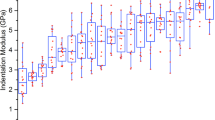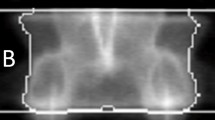Abstract:
The stiffness and strength of cancellous bone are important in the management of skeletal diseases such as osteoporosis. These properties are a function not only of bone density but also of bone architecture, some measure of which can be provided by quantitative ultrasound. The ability of quantitative ultrasound and bone mineral density (BMD) to predict stiffness and strength of human femoral heads removed from live subjects during hip replacement was assessed. Stiffness and strength were measured using a uniaxial compression test. Ultrasound velocity was measured using the pulse-submersion technique (McClue CUBAResearch) and BMD using DXA (Lunar DPX-L). Ultrasound velocity (quantitative ultrasound) and stiffness varied with the three orthogonal directions, the highest significance being between the proximo-distal (PD) and antero-posterior (AP) directions (p < 0.0001) for stiffness and p = 0.0003 for velocity). Ultrasound velocity was significantly correlated with compressive bone strength (r = 0.76, p < 0.0001) and stiffness (r = 0.79–0.83, p < 0.0001). BMD was also significantly correlated with compressive strength (r = 0.82, p < 0.0001) and stiffness (r = 0.66–0.81, p < 0.001). Using multiple regression analysis both BMD and velocity were significant predictors of strength (r = 0.88, p = 0.0004 and 0.0054 respectively) and stiffness r = 0.92, p = 0.0001 and 0.0003 respectively). BMD and velocity were still independent significant predictors of both stiffness (r = 0.93, p < 0.0001 and 0.0001 respectively) and strength (r = 0.89, p < 0.0001 and 0.02) when they combined as a product (BMDn*Vm). This suggests that BMD measured using DXA, if used in conjunction with ultrasound velocity, may be able to improve osteoporosis risk assessment. The information about femur anisotropy may also be important for hip prosthesis and in vivo modelling.
Similar content being viewed by others
Author information
Authors and Affiliations
Additional information
Rights and permissions
About this article
Cite this article
Njeh, C., Kuo, C., Langton, C. et al. Prediction of Human Femoral Bone Strength Using Ultrasound Velocity and BMD: An In Vitro Study. Osteoporos Int 7, 471–477 (1997). https://doi.org/10.1007/s001980050035
Issue Date:
DOI: https://doi.org/10.1007/s001980050035




